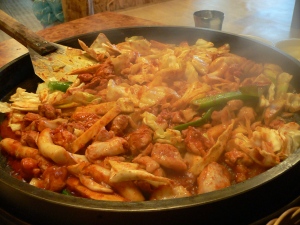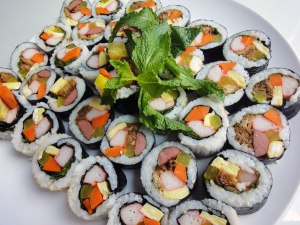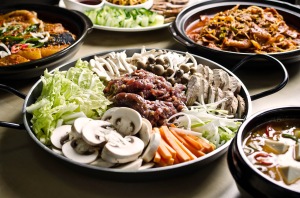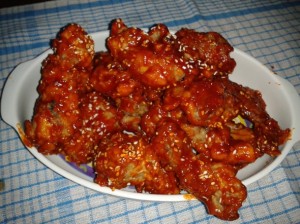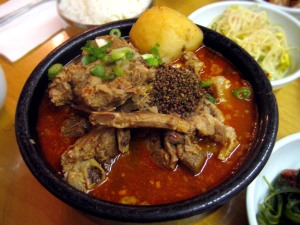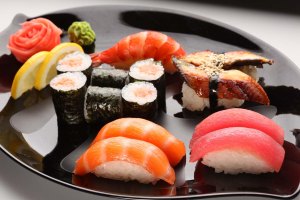TOP FIVE FOREIGN FRIENDLY FOODS IN KOREA
Never been to South Korea before? Wondering what to eat when you get there? Are you interested in trying out different Korean Food? Here is a list of the TOP 5 foods that expats find delicious in South Korea.
Dak galbi
Dak galbi, also romanized dalk galbi, is a popular Korean dish generally made by stir-frying marinated diced chicken in a gochujang (chili pepper paste) based sauce, and sliced cabbage, sweet potato, scallions, onions, ggaennip, and tteok (rice cake) together on a hot plate.[1] It is a local specialty food for the city of Chuncheon, Gangwon Province, where dak galbi originates. Because of its origin, the dish is also called Chuncheon dak galbi.[2]
It is said that dak galbi appeared after the late 1960s as an inexpensive anju (food that is eaten while drinking) in small taverns, on the outskirts of the city to replace the comparatively expensive gui dishes which are grilled over charcoal. The dish has spread to the main districts of Chuncheon, where the livestock industry thrives and offers fresh ingredients with no need for refrigeration. There is a street known as dak galbi golmok (dak galbi alley) which has a high concentration of dak galbi restaurants.[3] Due to the city’s northern location, it is a common destination for conscripted soldiers on leave.[2]
Gimbap
Gimbap or kimbap is a popular Korean dish made from steamed white rice (bap) and various other ingredients, rolled in gim (sheets of dried laver seaweed) and served in bite-size slices.[2] Gimbap is often eaten during picnics or outdoor events, or as a light lunch, served with danmuji or kimchi.
Gimbap is derived from Japanese futomaki (Makizushi) during the Japanese rule (1910-1945).[4][5][6][7][8] but now has certain distinctive elements not found in Japanese-style makizushi. Whereas the essence of Japanese sushi is vinegared rice, gimbap does not use rice vinegar but rather sesame oil.
Bulgogi
Bulgogi (Korean pronunciation: [pulɡoɡi]) or neobiani[1] is a Korean dish that usually consists of grilled marinated beef. It is listed at number 23 onWorld’s 50 most delicious foods readers’ poll compiled by CNN Go in 2011.
Bulgogi is made from thin slices of sirloin or other prime cuts of beef. Before cooking, the meat is marinated to enhance its flavour and tenderness with a mixture of soy sauce, sugar, sesame oil, garlic, pepper and other ingredients such as scallions, ginger, onions or mushrooms, especially white button mushrooms or matsutake. Sometimes, cellophane noodles are added to the dish, which varies by the region and specific recipe.
Bulgogi is traditionally grilled, but pan–cooking has become popular as well. Whole cloves of garlic, sliced onions and chopped green peppers are often grilled or fried with the meat. This dish is sometimes served with a side of lettuce or other leafy vegetable, which is used to wrap a slice of cooked meat, often along with a dab of ssamjang, or other side dishes, and then eaten together.
Yangnyeom Tongdak (Korean Friend Chicken)
Korean fried chicken or seasoned chicken (Korean: 양념 치킨 yangnyeom chicken) is a fried chicken dish prepared in a Korean style. It is consumed as a meal, fast food at bars, or as an after meal snack in Korea.
Korean fried chicken differs from typical American fried chicken by being fried twice. This results in the skin being crunchier and less greasy. Furthermore, Korean-style chicken is not characterized by the crags and crusty nubs associated with American fried chicken as described by Julia Moskin of The New York Times as a “thin, crackly and almost transparent”. The chickens are usually seasoned with spices, sugar, and salt, prior to and after being fried. Korean fried chicken restaurants commonly use small or medium sized chicken, in other words, younger chickens resulting in more tender meat. Pickled radishes, beer, and soju are often served with Korean fried chicken.
Gamjatang
Gamjatang or pork bone soup is a spicy Korean soup made with pork spine or ribs, vegetables, green onion, hot peppers and ground wild sesameseeds. It is a matter of contention whether the name of the soup comes from the word for potato (감자; gamja) or not, because the soup is frequently served without potatoes.
The vertebrae are usually separated with bits of meat clinging to them. The vertebrae is boiled in high temperatures to soften the meat. To remove the meat, one must use an instrument such as a chopstick. The meal is usually served with kimchi and a bowl of rice. This food is served as a lunch or dinner and often as a late night snack as well.
The soup base is a deep red colour from the red hot peppers.
Everything you need to know about eating sushi
For you beginners……………Start with the lighter, more delicate fish and then move on to the darker and fattier ones. You’ll give yourself the chance to enjoy the lighter flavors of the white fish like snapper without overwhelming your taste buds with the fatty richness of tuna.






